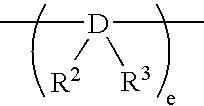Chlorinated propylene polymer, process for producing the same and use of the same
a technology of chlorinated propylene and polypropylene, which is applied in the direction of catalyst activation/preparation, metal/metal-oxide/metal-hydroxide catalyst, etc., can solve the problems of reduced durability, inevitably caused by reduction of base polymer, and difficulty in obtaining satisfactory solubility, etc., to reduce the properties inherent to polypropylene, the effect of low environmental burden and high solubility
- Summary
- Abstract
- Description
- Claims
- Application Information
AI Technical Summary
Benefits of technology
Problems solved by technology
Method used
Image
Examples
preparation example 1
Preparation of Low Crystalline Propylene Polymer
[0167] (a) Preparation of Catalyst
Preparation of (1,2′-dimethylsilylene)(2,1′-dimethylsilylene)-bis(3-trimethylsilylmethylindenyl) zirconium dichloride:
[0168] In a Schlenk tube, 3.0 g (6.97 mmol) of a lithium salt of (1,2′-dimethylsilylene)(2,1′-dimethylsilylene)-bis(indene) were dissolved in 50 ml of THF and the solution was cooled to −78° C., to which 2.1 ml (14.2 mmol) of (iodomethyl) trimethylsilane was added dropwise. The mixture was stirred at room temperature for 12 hours and the solvent was removed by distillation. Then 50 ml of ether was added to the residue and the solution was washed with a saturated ammonium chloride solution. The organic phase was separated and dried. The solvent was removed by distillation to obtain 3.04 g (5.88 mmol) of (1,2′-dimethylsilylene)(2,1′-dimethylsilylene)-bis(3-trimethylsilylmethylindene) was obtained (yield 84%).
[0169] Next, under a nitrogen flow, the thus obtained 3.04 g (5.88 mmol) of ...
example 1
[0176] The propylene homopolymer (5 g) prepared in the above Preparation Example 1 was placed in a 100 ml flask whose inside was substituted with nitrogen, to which 40 ml of sulforan dehydrated by nitrogen bubbling. The mixture was then stirred at 80° C., to which 2 g of sulfonyl chloride were added. Then the mixture was stirred for 20 hours. The reaction mixture was poured in methanol and the precipitates were collected and dried to obtain 5 g of chlorinated polypropylene. The chlorinated polypropylene had a chlorine content of 0.6% by mass, [η] of 0.31 dL / g, [mm] of 59 mol %, Tm-D of 70° C. and a weight average molecular weight (Mw) of 62,000. To the thus obtained chlorinated polypropylene homopolymer (1 g) was added 10 ml of n-heptane. The mixture was then stirred at 30° C. The polymer was found to be completely dissolved to give a homogeneous solution.
example 2
[0178] The propylene homopolymer (10 g) prepared in the above Preparation Example 1 was placed in a 200 ml flask whose inside was substituted with nitrogen, to which 100 ml of 1,1,1-trichloroethane dehydrated by nitrogen bubbling. The solids were dissolved under reflux, to which 5 ml of sulfonyl. chloride and a solution of 0.1 g of azobisisobutyronitrile (AIBN) dissolved in 3 ml of trichloroethane were added dropwise in this order. Then the mixture was stirred for 2 hours. The reaction mixture was then poured in methanol and the precipitates were collected and dried to obtain 5 g of chlorinated polypropylene. The chlorinated polypropylene had a chlorine content of 5.9% by mass, [η] of 0.25 dL / g, [mm] of 60 mol % and a weight average molecular weight (Mw) of 42,000. To the thus obtained chlorinated polypropylene (1 g) was added 10 ml of n-heptane. The mixture was then stirred at 30° C. The polymer was found to be completely dissolved to give a homogeneous solution.
PUM
| Property | Measurement | Unit |
|---|---|---|
| Tm- | aaaaa | aaaaa |
| melting point | aaaaa | aaaaa |
| melting point | aaaaa | aaaaa |
Abstract
Description
Claims
Application Information
 Login to View More
Login to View More - R&D
- Intellectual Property
- Life Sciences
- Materials
- Tech Scout
- Unparalleled Data Quality
- Higher Quality Content
- 60% Fewer Hallucinations
Browse by: Latest US Patents, China's latest patents, Technical Efficacy Thesaurus, Application Domain, Technology Topic, Popular Technical Reports.
© 2025 PatSnap. All rights reserved.Legal|Privacy policy|Modern Slavery Act Transparency Statement|Sitemap|About US| Contact US: help@patsnap.com



